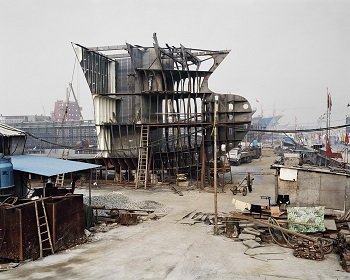The dark side of progress

The second-floor corridor in the old Victoria School wing of Goodes Hall sees a lot of foot traffic. Home to seminar and meeting rooms, classrooms and a graduate student lounge, it’s often congested with rushing students, faculty and staff.
Those who pause for a moment to actually register their surroundings are often stopped in their tracks at the sight of seven extraordinary works by the renowned Canadian photographer Edward Burtynsky. His photographic descriptions of global industrial landscapes are included in the collections of more than 60 major museums around the world, including the National Gallery of Canada, and New York City’s Guggenheim Museum and Museum of Modern Art.
The artwork in Goodes Hall is an off-site installation on loan from the Agnes Etherington Art Centre at Queen’s, and is part of the artist’s gift to the university of 47 works in 2006. The current installation was curated by the Centre’s staff and focuses on works from the artist’s acclaimed China Series.
How they came to be displayed in the business school is a tale of a chance encounter between Dean David Saunders and the art centre’s director, Jan Allen. “David is an admirer of Burtynsky’s work,” says Jan. “He said there was a location in Goodes Hall that was intended for the display of art, and wouldn’t it be wonderful to display some of Burtynsky’s pieces there?”
After assuring herself that the location would be safe for these valuable works and that the lighting and distance from direct heat sources were ideal, the project went ahead. For those involved, the installation was much more than an exercise in filling vacant wall space.
Burtynsky’s work documents the impact of human activity on the environment, from resource extraction through production of manufactured goods to transportation, consumption and waste accumulation. “They’re fascinating, aesthetically compelling images that offer a wordless critique of such systems,” says Jan. They provoke challenging questions: Where does our waste go and how is it processed? Is it being disposed of at the expense of third-world workers employed to process the waste?
“I am a huge fan of Edward Burtynsky’s work,” says David Saunders. “He has a terrific eye and clearly expresses the dark side of ‘progress’ in his photographs. All business students should be aware not only of his work, but also of the issues that he documents.”
Jan is equally aware of the teachable moments that the Burtynsky works offer in a business school environment. “I think it’s important for business students — the people who will be steering our economic future — to both celebrate the power of economic systems and also recognize their destructive aspects.”
The current works are scheduled to be replaced by others from the Burtynsky collection early in 2015. For more information about the collection, visit agnes.queensu.ca.
